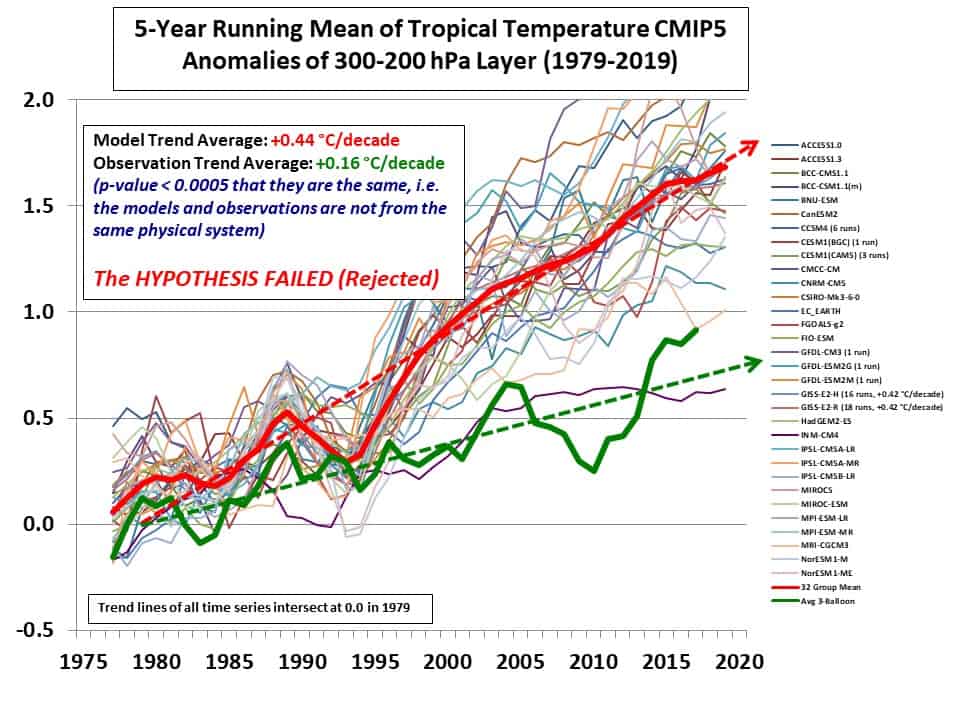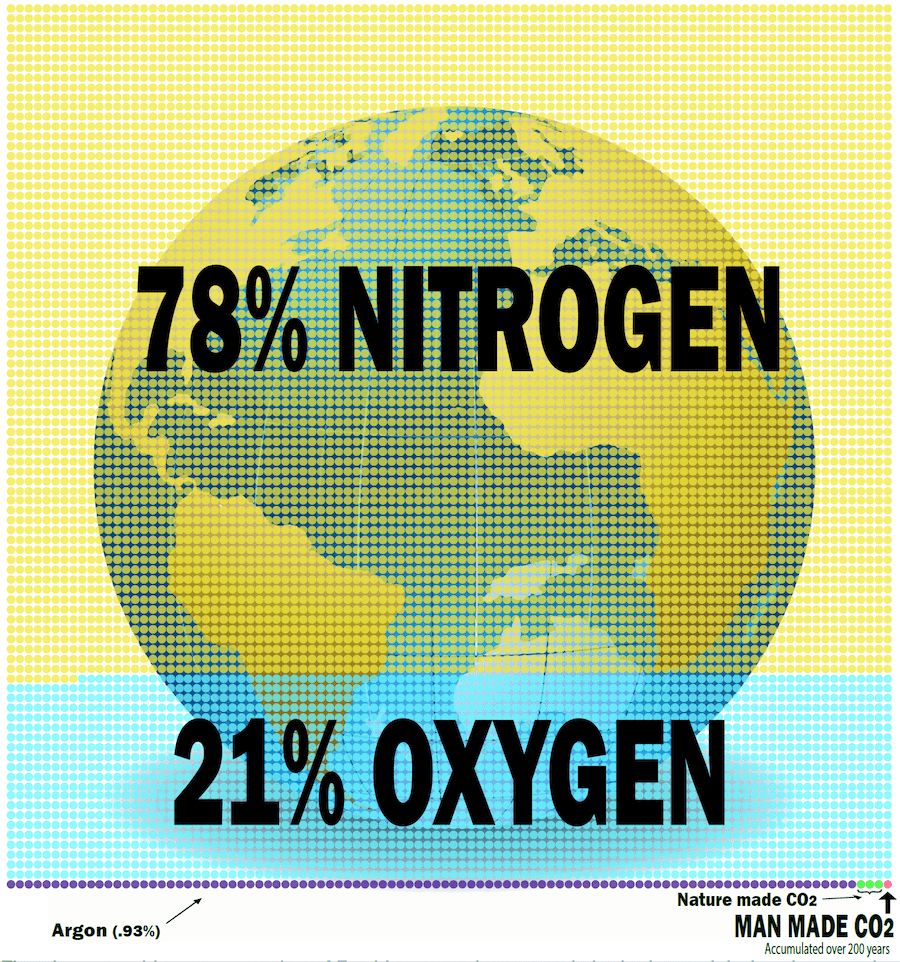
Most of us are well aware that the idea that 97% of scientists believe that mankind controls the thermostat of Planet Earth is ridiculous. After all, you could not get 97% of any group to agree on practically anything, especially something as complicated as climate change science. In fact, the percent of scientists who are confident that man’s use of fossil fuels that emit carbon dioxide (CO2) has an insignificant effect on our planet’s climate is likely closer to 50%. Of those who are outspoken on the issue, such as yours truly, many have come to make up a cottage industry. Most of these folks cling to some vague numerical answer to the question of how much is the effect of CO2, even though they admit it to be insignificant.
Unfortunately, these diverse but vocal “luke-warmers” sell their calculations through the media to a near scientifically illiterate public who are led to believe that any small numbered impact of CO2 on our atmospheric temperature is proof that it is actually significant, and, regardless of how small, it could lead to the end of the world as we know it in about 12 years. Or are we down to seven now?
While mostly well-meaning and competent scientists, the luke-warmers are inhibiting our ability to set the world straight as to the delusion that most of the public embrace, namely that burning fossil fuels and emitting carbon dioxide (CO2) are terrible things. In fact, Earth has been starving of CO2 for a very long time and is now, relatively speaking, precipitously close to the 150 parts per million (ppm) of the gas at which plants begin to die, followed by the animals that depend on the plants and ultimately us, Homo sapiens. Of course, we depend on both plants and animals to survive. Before about 1850, only 280 ppm of CO2 existed in the atmosphere, going back thousands of years. Following the growth which occurred since the Industrial Revolution, we have climbed to 420 ppm of CO2, and, happily, the Earth is “greening” very significantly.
Rather than be thankful for the increase in this miracle molecule, which provides for life on our planet, some in search of power and often money desire to change our political and economic system by demonizing it. They wish us to adopt socialism, open our borders, redistribute our wealth and form a “New World Order” where collectivist rules and individual freedom are dramatically reduced.
They tell us that the world could and should run on unreliable, expensive wind and solar power. Many of these ideologues must know it can’t be done but recognize that such an energy transition would subjugate the world’s population to near-total government control, passing out energy as they choose, which is apparently their ultimate goal.
They rely, not on physical evidence, but on mathematical equations that are called models of how this complex system of our climate works. The well-intended luke-warmers do expose some of the fallacies of these models but, unfortunately, generally refuse to declare that the emperor has absolutely no clothes.
In consultation with Astrophysicist Willie Soon and the late Tom Wysmuller, formerly of NASA, the senior author of this article chose the following twelve variables which, simple logic indicates, must be considered when attempting to predict future temperatures and climate impacts on our planet. It turns out that we can only guess at the influence of these factors because we do not fully understand any of them. They include:
1- changes in seasonal solar irradiation
2- energy flows between the ocean and the atmosphere
3- energy flows between the air and land
4- the balance between the Earth’s liquid water, water vapor, and ice
5- the impact of clouds
6- understanding the planet’s ice
7- mass change among ice sheets, sea level, and glaciers
8- the ability to factor in the consequence of hurricanes and tornadoes
9- the impact of vegetation on temperature
10- tectonic movement on the ocean floor
11- the differential rotation between the Earth’s surface and the planet’s core
12- the solar system’s magnetic field and gravitational interaction.
Because these variables are not well understood, if they are considered at all, they require a model maker to make educated guesses as to how they relate to each other and their individual impacts on climate. More specifically: how do they impact the Earth’s thermostat?
A recognition of our ignorance regarding these variables should convince anyone that mathematical modeling predictions are without merit. Solutions to sophisticated mathematical equations obviously prove nothing if they have little relation to physical reality.
Nevertheless, the government has poured billions of dollars into the coffers of academic institutions to churn out useless predictions based on the equations they think simulate a system so complex it is truly beyond comprehension. More than 100 climate models are financed by the United States government, few of which agree with each other (see below for a sample of how models (the many colored lines) compare with actual observations (dark green line). Essentially none have accurately predicted anything meaningful concerning our climate over the past 30 years of their operation.

We have thus far failed to educate our politicians, our students of science, and the public in general about the truly impossible task of predicting the Earth’s future temperatures. And yet governments across the world appear willing to destroy their economies by eliminating the use of fossil fuels to support a terrible presumption.
In an appeal to our reader’s common sense, we include two graphics. The first one below shows how much man-produced CO2 exists in the atmosphere as a greenhouse gas relative to all greenhouse gases in the atmosphere. The second chart shows how much CO2 exists in our atmosphere relative to all other gases in our atmosphere. Each chart has 10,000 dots, each representing one ten thousandths of the whole of greenhouse gases in the first chart and one ten thousandths of the atmospheric gas in the second chart.


On the first chart, you can see that, while CO2 makes up 3.6% of all greenhouse gas, man’s contribution of CO2 from factories, power plants, and automobiles is only 0.12% of all greenhouse gases. On the second chart, you can see that total CO2 in the atmosphere makes up four ten thousandths (.0004) of all atmospheric gases, but man’s contribution is only one ten thousandths (.0001). Every reader should be able to conclude that our way of life is not being endangered by our CO2 emissions.
While there are many scientists building climate models which are scaring the public to enlarge government to “save the planet,” there are also many sound scientists who recognize the absurd exaggeration of the impact of our CO2 emissions on our planet. But many of the latter still work with mathematical models to show how tiny the impact of CO2 is on our Earth. The problem is that by their professing CO2’s impact as being small, these luke-warmers are giving the proverbial “inch,” which allows the alarmists to take a “mile.”
It is high time that we all stop fighting alarmist numbers with our small numbers. The only number that matters is ZERO. The real impact of man-made CO2 on global average air temperature, and consequently on the Earth’s climate, is essentially ZERO.
We are not in a battle over numbers. We are in a battle to protect our way of life. If we lose this battle, the alarmists will take us back to life as it was in the 19th century. However, this time things will be much worse, for, not only do we have billions more to feed, clothe, and shelter, but the alarmists will have installed a government capable of controlling every aspect of our lives. This is the fight of our lifetime! We must not lose it!
No comments:
Post a Comment